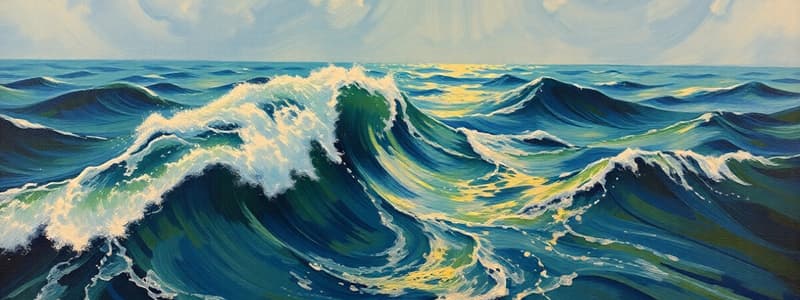Podcast
Questions and Answers
What is the definition of amplitude in the context of waves?
What is the definition of amplitude in the context of waves?
Amplitude is the maximum displacement of points on a wave from their equilibrium position.
How is wavelength defined in wave physics?
How is wavelength defined in wave physics?
Wavelength is the distance between consecutive crests or troughs of a wave.
Identify a part of the electromagnetic spectrum that has a frequency lower than microwaves.
Identify a part of the electromagnetic spectrum that has a frequency lower than microwaves.
Radio waves.
What is the speed of microwaves in air?
What is the speed of microwaves in air?
Given the wavelength of a microwave is 2.7 cm, how do you calculate its frequency?
Given the wavelength of a microwave is 2.7 cm, how do you calculate its frequency?
Calculate the frequency of a microwave with a wavelength of 2.7 cm. (Use 3.0 × 10^8 m/s for speed)
Calculate the frequency of a microwave with a wavelength of 2.7 cm. (Use 3.0 × 10^8 m/s for speed)
Why is knowing the wavelength of a wave important in physics?
Why is knowing the wavelength of a wave important in physics?
What effect does the medium have on the speed of microwaves?
What effect does the medium have on the speed of microwaves?
What is a correct statement about waves in relation to energy, information, and matter?
What is a correct statement about waves in relation to energy, information, and matter?
Explain why waves do not transfer matter as they propagate.
Explain why waves do not transfer matter as they propagate.
What would the path of a ray of light look like in air before entering a glass optical fibre?
What would the path of a ray of light look like in air before entering a glass optical fibre?
Identify the wave behavior that causes the light ray to bend when it enters the optical fibre.
Identify the wave behavior that causes the light ray to bend when it enters the optical fibre.
What factors affect the degree of refraction of light as it transitions between air and glass?
What factors affect the degree of refraction of light as it transitions between air and glass?
Discuss how optical fibers utilize the principles of waves for communication.
Discuss how optical fibers utilize the principles of waves for communication.
Describe how the frequency and wavelength of a wave influence its energy and information carrying capacity.
Describe how the frequency and wavelength of a wave influence its energy and information carrying capacity.
Why is it important for optical fibers to minimize loss of light during transmission?
Why is it important for optical fibers to minimize loss of light during transmission?
What is the relationship between wave speed, frequency, and wavelength?
What is the relationship between wave speed, frequency, and wavelength?
If the frequency of a wave is 25 Hz and the wavelength is unknown, what formula would you use to find the wavelength?
If the frequency of a wave is 25 Hz and the wavelength is unknown, what formula would you use to find the wavelength?
What might the arbitrary units measured by the analogue meter indicate about the microwave strength?
What might the arbitrary units measured by the analogue meter indicate about the microwave strength?
How does varying the distance between the microwave source and receiver affect the detected microwave strength?
How does varying the distance between the microwave source and receiver affect the detected microwave strength?
Why might microwaves be used in an experimental setup to demonstrate wave properties?
Why might microwaves be used in an experimental setup to demonstrate wave properties?
In the context of this experiment, what would an increase in the analogue meter reading suggest about the environment?
In the context of this experiment, what would an increase in the analogue meter reading suggest about the environment?
If the observed frequency is inconvenient for measurements, which alternative method could enhance the experiment's data collection?
If the observed frequency is inconvenient for measurements, which alternative method could enhance the experiment's data collection?
What role does a ruler play in the setup described for the microwave experiment?
What role does a ruler play in the setup described for the microwave experiment?
Flashcards are hidden until you start studying
Study Notes
Amplitude and Wavelength
- The amplitude of a wave is the maximum displacement of a point on the wave from its rest position.
- The wavelength of a wave is the distance between two successive crests or troughs.
Microwaves
- Microwaves are a part of the electromagnetic spectrum.
- The part of the electromagnetic spectrum with a lower frequency than microwaves is infrared radiation.
- The speed of a wave is calculated by multiplying its frequency and wavelength.
- The frequency of a microwave with a wavelength of 2.7 cm is 1.1 × 10^10 Hz.
Optical Fibres
- Optical fibres use light waves for communication.
- Waves transfer energy and information without transferring matter.
- When a ray of light passes from air into a glass optical fibre, it bends towards the normal. This is due to refraction.
- The refractive index of a medium is the ratio of the speed of light in a vacuum to the speed of light in the medium.
- The refractive index of glass is greater than the refractive index of air.
- This means that the speed of light in glass is less than the speed of light in air.
- As the ray of light passes from air into glass, it slows down and bends towards the normal.
Microwave Investigation
- The strength of the microwaves detected by the receiver is measured in arbitrary units.
- Varying the distance between the microwave source and the receiver affects the strength of the microwaves detected.
Studying That Suits You
Use AI to generate personalized quizzes and flashcards to suit your learning preferences.




